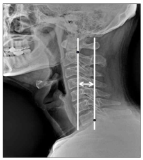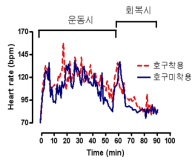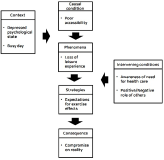
This study was designed to investigate the effects of combined treatment of chiropractic and PNF exercise on musculoskeletal function in forward head posture patients. Thirty patients volunteered to participate in the study as subjects, and they were divided into one of three groups, i.e., chiropractic group (n=10), PNF exercise group (n=10), and combined treatment of chiropractic and PNF exercise group (C+P group; n=10). Subjects in three groups went through each program for 25 min/session, three times/wk for eight weeks. Cervical alignment, cervical muscular strength and endurance, and cervical range of motion were measured and compared among groups and between pre- and post-test utilizing two-way ANOVA with repeated measures. Main results of the present study were as follows: 1) All variables regarding cervical alignment increased significantly in all three groups. The changes in C+P group were more significant than other two groups. 2) All variables regarding cervical muscular strength and endurance increased significantly in all three groups. 3) All variables regarding cervical range of motion increased significantly in all three groups. The changes in ROM regarding flexion and extension in C+P group were more significant than other two groups. It was concluded that all three treatments applied in this study would be effective for functional recovery of the musculoskeletal function in forward head posture patients. Especially, combination of chiropractic and PNF pattern exercise would be the most effective intervention for the patients.


The purpose of this study was to describe psychological changes and variables of injured elite athletes during sport injury rehabilitation. 5 injured elite athletes were selected as participants, and open-ended questionnaires, participant observation, and in-depth interview were used for collecting data. Results from the data were analyzed through transcription, coding, and categorization with inductive method. To validate the results of this study, triangulation, in-depth description, member checks, and peer debriefing were used, and findings of this study were as follow. The participants showed negative psychological state such as fear of return to play and anxiety during the initial rehabilitation program, but their psychological state was changed positively such as recovery of confidence and desire of return to play at the end of program. However, the specific psychological changes of each participant showed several differences according to participant's surrounding environment and situation during the rehabilitation program. All findings have important implications for implementing and developing rehabilitation program, so needs to be investigated further.
PURPOSE The purpose of this study was to investigate the current injury status and traits, including damage area, cause of damage based on the situation, and type of occurrence by age group for middle and high schools, university, and professional athletes, in record competition sports (swimming, track and field, and weightlifting). METHODS The study included 503 athletes enrolled in the Korean Sport & Olympic Committee in 2020, and an online survey was conducted using the R statistical program. RESULTS Approximately 38.4% athletes suffered injuries with weightlifting (0.81 times at university) and weightlifting (7.02 times at university) during training. The lower extremities were the most affected areas in all age groups (53.8% in middle school, 48.6% in high school, 44.4% in university, and 47.4% in professional). The causes of damage found to occur most frequently were ‘lack of physical strength, overuse or lack of rest, and recurrence’ and external factors, including ‘facility programs and weather problems.’ The results showed that internal factors during training were mostly associated with ‘overuse or lack of rest and excessive attempts at skills’, while external factors were found to occur in ‘weather problems’. According to the classification of each event, the top priority of frequent damage according to the damaged area was skin bleeding of the head in swimming and muscle inflammation in the torso and upper and lower extremities. Track and field resulted in muscle inflammation in the head, torso, and upper and lower extremities. Weightlifting caused damage to the head and torso, resulted in spinal diseases (disc, spinal stenosis, etc.), and muscle inflammation in the upper and lower extremities. CONCLUSIONS This study highlighted changes in the training environment and training environment, including level-specific physical training, reinforcement programs, scientific access to specific skills, sufficient rest and recovery, and continuous improvement of facilities and equipment.
Purpose The purpose of this study is to examine the location, rate, cause, and types of injuries according to the injured area by age and sports in female athletes. Methods The subject of the study was 426 female athletes who were registered as combat sports(Judo, Taekwondo, Fencing) athletes at the Korean Sports & Olympic Committee. We collected the data via online questionnaires, and conducted a frequency analysis using R statistics program. Results As a result, 51.4% of athletes experienced injuries in the past year, and the highest injury rate was shown in Taekwondo-University(0.43) during competition and Taekwondo-Professional(5.55) during training. The cause of injuries during competition was mainly due to 'as a result of me or the opponent's hittings, skills, or fouls' among internal factors, and 'recurrent injuries' among external factors. Among internal factors during training except for torso area and professional athletes, most of the injuries were also caused by ‘as a result of me or the opponent's hittings, skills, or fouls’ and ‘recurrent injuries’ among external factors. The frequency of injury was the highest in the lower extremity area across all age groups. The most frequently injured area, in the case of Judo, is skin-bleeding in the head, skin-bruise, muscle-inflammation, bone-fracture, spondylopathy(disc, stenosis, etc.) in the torso, muscle-inflammation in the upper extremity, ligament-sprain, rupture in the lower extremity. Taekwondo athletes had skin-bruise in the head, upper and lower extremities, and muscle-inflammation in the torso area, as the frequent injury cases, and Fencing athletes had all skin-bruise regardless of injuries. Conclusions The results of this study will be used to take measures for preventing injuries or to change training programs.

The purpose of this study was to investigate the effect of wearing of safeguard devices on various blood ions (i.e., Na+, K+, Ca2+) concentrations, gas parameters (PO2, PCO2, hematocrit [Hct], hemoglobin [Hb], Saturated [Sat] O2), and energy substrates (i.e., glucose, free fatty acid [FFA], lactate) concentrations during Kumdo training. Research scope extended to examine the heart rate changes during each exercise sessions. In order to achieve the research goal, 10 male elite Kumdo players, who play for G city in Gyeongsangbuk-do, were participated, and their mean maximum oxygen uptake level was 51.2(±6.1)mL· kg-1min-1. All subjects undertook Kumdo training sessions twice, which carefully pre-planned and consisted of routinely carrying out exercise program. Training period for each session was 80 min long including 10 min each for warm-up and warm-down period, but the conditions with wearing body protection devices were different following either with wearing complete set of safeguard devices or without wearing any safeguard devices except general training cloth. Heart rate was measured by every minute interval. K+ and Ca2+ showed interaction effect between the conditions with wearing safeguard devices and conditions with time of Kumdo training. Hct and Hb level significantly increased after 60 min Kumdo exercise regardless of wearing safeguard devices. Kumdo training induced dropping of blood pH independently with wearing safeguard device conditions, however the values and/or concentrations of PO2, Na+, glucose, lactate, Sat O2were significantly increased. Heart rate was maintained marginally higher values throughout exercise period when safeguard devices were worn. Based on these results, it was concluded that wearing the safeguard devices could possibly be causing a physiological metabolic changes, and this may be drawn by increased body fluid loss and energy expenditure. Further study should be undertaken to examine the effects of wearing safeguard devices on hitting intensity and hormone secretion and concentrations, that closely associated with body fluid and ion balance during Kumdo exercise and/or training.

Purpose The valuable impacts of exercise-intervention in diverse type of cancer patients were rationally well-prescribed, though many experimental and review researches already performed in this fields. Generally, cancer-related fatigue and pain remains one of the most prevalent problems for cancer populations. Therefore, exercise has become increasingly significant in cancer prevention and progression. The purpose of this recent study was to analyze the combined exercise program on cancer-related fatigue, pain, quality of life and cancer prognosis in diverse type of cancer patients. This study analyses the safety and feasibility of exercise intervention in diverse stages of cancer patients such as early stage, advanced stage and even metastatic periods in cancer populations. we also wanted to know the impacts of dose-response trial of aerobic and resistance exercise on quality of life in cancer survivors. Methods we conducted a comprehensive PubMed/MEDILINE electronic database from Jan 2015 to August 2020. The reference lists of eligible experimental research articles and relevant systemic review articles were checked. Inclusion criteria were adult cancer survivors from randomized controlled trials performing well-tailored exercise intervention programs to diverse type of cancer patients, Using predefined search items ‘exercise-intervention, cancer & immunology’. Based on reference search, more than 100 articles were identified whereas 30 research papers met the inclusion criteria and were well connected with exercise-intervention and cancer progression. we analyzed the connections between physical exercise and cancer intervention in the main text. Results Moderate to vigorous exercise (aerobic and resistance exercise) revealed to decreased level of cancer-related fatigue, pain, and cancer-related symptoms, however increased level of sleep quality, activities of daily living, exercise performance and health- related quality of life. Exercise intervention reduced pro-inflammatory markers and oxidative stress as well as insomnia, fatigue, pain symptoms whereas it enhanced the antioxidant systems and immune functions. In addition, home-based aerobic physical exercise might enhance muscular strength and quality of life in many types of cancer survivors. Psychological intervention also effective for reducing cancer-related fatigue and pain during and after cancer treatment. they might be the much better intervention than available pharmaceutical options. we believe that it is the related mechanisms of immune cell mobilization and activation such as NK cells which is induced by the activation of sympathetic system during and after physical exercise. Conclusion According to the aforementioned results, it was concluded that implementation of exercise intervention appear to be the best non-pharmaceutical interventions for cancer populations, and also revealed to be safe and feasible in early and advanced stages, although not in the metastatic periods. Sometimes, psychological intervention such as mindfulness-based stress reduction (MBSR) might be useful in reducing anxiety, depression, fatigue, pain and enhancing quality of life, quality of sleep for cancer populations. we can conclude, exercise-intervention might not just be prevention effect but might be therapeutics, however more studies are urgently needed to confirm the exercise intervention on the NK-receptors activation and immune connection of cancer populations.

Purpose The purpose of this study is to investigate the alienation and the overcoming process of the physical activity participation of people with Adventitious Visual Impairment(AVI) Methods 21 Adults with AVI were recruited and one on one semi-structured interview was conducted. Ground theory was used to analyze the data. Member check, peer debriefing was conducted to enhance the trustworthiness of this study. Results As a result, a total of 203 concepts were derived. This consisted of 21 subcategories and the common themes of the subcategories were categorized into nine categories. Specific results are as follows. First, the physical activity of people with AVI was directly affected by the sports facilities, physical activity programs, and professional instructor. This causal condition resulted in the loss of leisure experience in the context of the busy daily life and the depressed psychological state. Second, due to the perceived need of health care and the positive involvement of others, people with AVI came to expect the effect of exercise. Third, people with AVI participated in physical activity again as a tool to achieve the purpose of health improvement. This type of physical activity has a limitation that it can not guarantee the continuity of physical activity due to the limitation that it does not contain autonomy and interest of people with AVI. Conclusions Based on these results, the following suggestions were made. First, it is necessary to improve the environment for ensuring participation in physical activity of people with AVI. Moreover education and promotion of the effects and values of the exercise should be carried out for people with AVI and their guardians. Second, it is necessary to diversify physical activity types and reconstruct existing exercise programs.

Purpose The purpose of this study was to investigate the effect of a 10-week aerobic exercise training on cardiovascular function, atherosclerosis, and vascular endothelial function in elderly women. Methods Twenty impaired fasting glucose (IFG) and normoglycemic elderly women volunteered to participate in the study. The participants in aerobic exercise training group (TR: n=9) completed 20-40 minutes of aerobic exercise program at 30-50% HRR for 3 times per week during 10 weeks. The participants in control group (CON: n=11) were asked to maintain their normal life pattern during the same intervention period. Results Main results of the study were as follows: 1) There were no significant main effect or interaction in body weight, fat-free mass, fat mass, percent body fat, and body mass index. 2) There were no significant main effect or interaction in heart rate, stroke volume, cardiac output, total peripheral resistance (TPR), systolic blood pressure, diastolic blood pressure, mean arterial blood pressure, pulse pressure, and rate pressure product. However, interaction between group and test in TPR was close to statistically significant level (P =.054), and it tended to be decreased in TR group. 3) There was a significant main effect of test in high sensitivity C-reactive protein(hs-CRP), it tended to be decreased in TR group. There were no significant changes in total cholesterol(TC)/high density lipoprotein-cholesterol (HDL-C) ratio, triglyceride/HDL-C ratio, and low density lipoprotein-cholesterol/HDL-C ratio. 4) There were significant main effect of group, main effect of test, as well as interaction between group and test in % flow mediated dilation(FMD), and it increased significantly (P<.01) in TR group. Nitric oxide tended to be increased in TR group, even though it did not change significantly in both groups. Conclusions It was concluded that the 10-week aerobic exercise training would be beneficial for improvement of vascular endothelial function, resulting from the decrement of total peripheral resistance.
PURPOSE This study investigated the effects of moderate-intensity continuous exercise (MICE) and high-intensity interval exercise (HIIE), performed postprandially, on blood glucose, blood pressure, and blood lactate levels in men aged 40–50 with prediabetes and prehypertension. METHODS Twelve men with prediabetes and prehypertension were selected. After consuming a liquid meal, the participants participated in three trials: MICE, HIIE, and a non-exercise condition, with a one-week washout period between each trial. The trials were conducted in a counter-balanced manner to ensure equal energy expenditure across conditions. The intensity of the MICE trial was set at 70% of the heart rate reserve (HRR), whereas the HIIE trial alternated between 50% and 90% of HRR for 30 minutes. Blood glucose, blood pressure, and blood lactate levels were measured at various time points during each trial, and a two-way repeated-measures ANOVA was used for analysis. RESULTS 1) In the MICE trial, significant reductions were observed in blood glucose (at 15 and 30 minutes during exercise), systolic blood pressure (SBP) (at 50 minutes post-exercise), and diastolic blood pressure (DBP) (at 20, 40, 50, and 60 minutes post-exercise). 2) In the HIIE trial, significant reductions in blood glucose (at 15 and 30 minutes during exercise), SBP (at 40 minutes post-exercise), and DBP (at 40 minutes post-exercise) were observed. Blood lactate levels significantly increased. 3) When comparing the two exercise trials, blood glucose in the HIIE trials showed a recovery trend post-exercise, and blood lactate levels increased to a greater extent. CONCLUSIONS These findings suggest that both MICE and HIIE effectively lower blood glucose during exercise, but HIIE causes a more rapid post-exercise increase in blood glucose compared to MICE. In addition, MICE results in a smaller rise in blood lactate. Therefore, MICE is recommended for improving prediabetes and prehypertension. Future research should compare these effects in healthy individuals and examine long-term adaptations to repeated exercise.